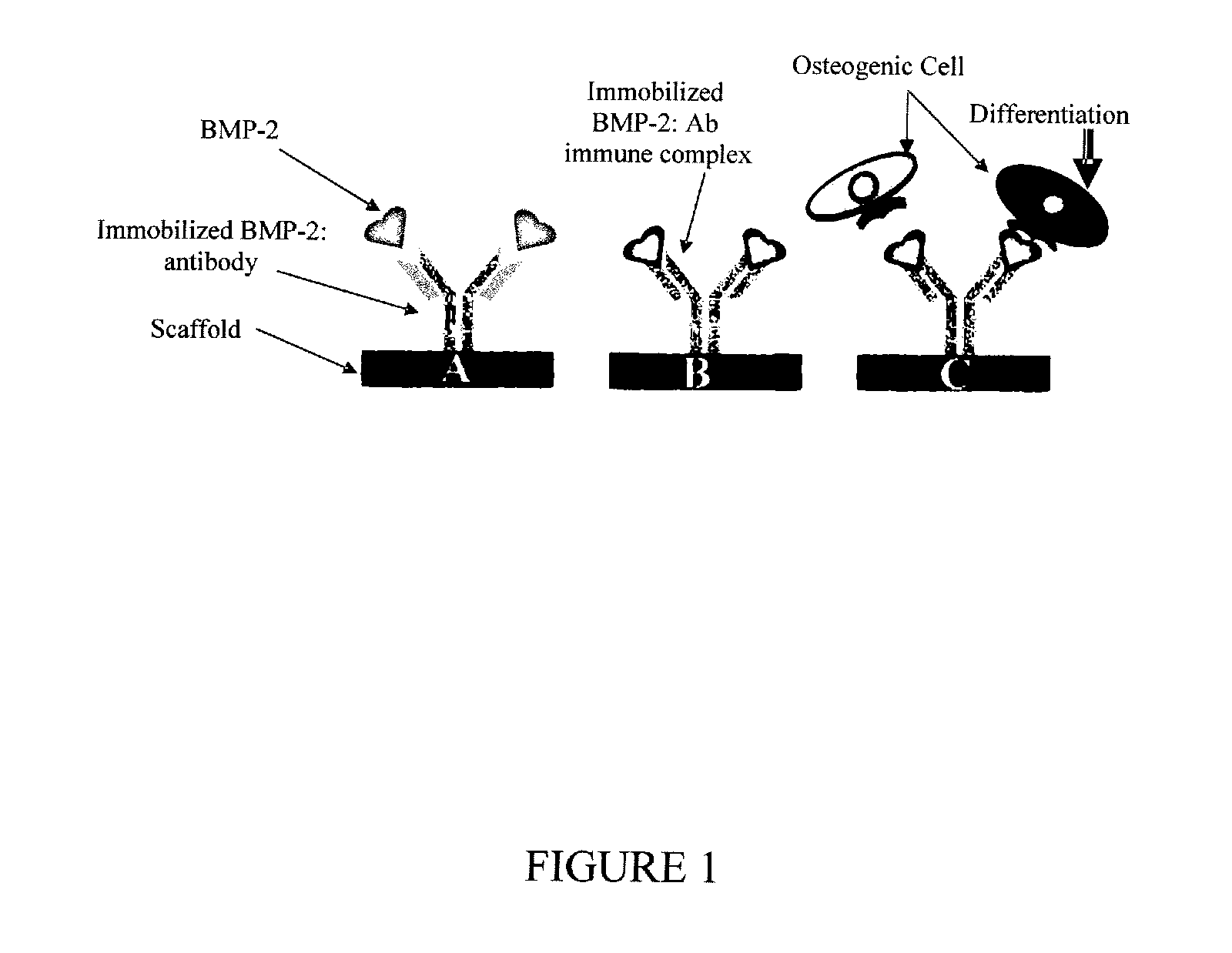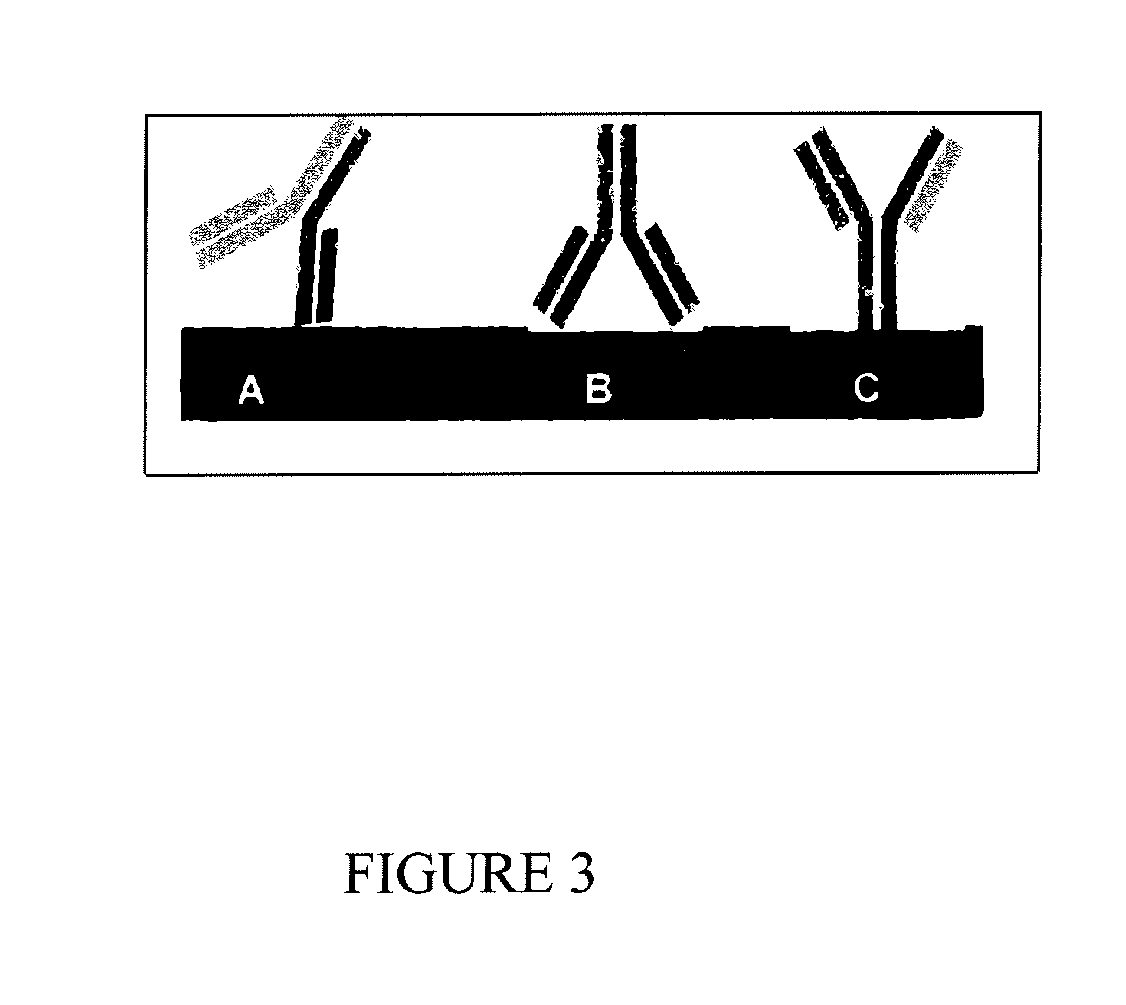Antibody mediated osseous regeneration
a technology of osseous regeneration and antibody, which is applied in the direction of antibody medical ingredients, prosthesis, drug compositions, etc., can solve the problems of autologous bone grafting, pain and significant cost, nerve injury, etc., and achieves high affinity, avoid adverse local or systemic immunological response, and the effect of high affinity
- Summary
- Abstract
- Description
- Claims
- Application Information
AI Technical Summary
Benefits of technology
Problems solved by technology
Method used
Image
Examples
example 1
BMP-2 Specific Antibodies
[0074]Approximately two dozen commercially available anti-BMP-2 antibodies were tested, including monoclonal antibody clone 3G7S (IgG2a; Abnova, Taipei, Taiwan), monoclonal antibody clone 4B12 (IgG2a; Abnova), and polyclonal Ab (pAb) (Rabbit, rhBMP-2, Biovision, Mountain View, Calif.). In preliminary studies, three monoclonal antibody clones were tested, including mAb1 (clone 100221), mAb2 (clone 100230) and mAb3 (clone 65529). A polyclonal antibody specific for BMP-2 was also tested, pAb (affinity purified goat anti-BMP-2 antibody).
[0075]Additionally, a murine monoclonal antibody (mAb) library was created. Monoclonal antibodies specific for the biomolecule bone morphogenetic protein (BMP-2) were generated according to standard procedures (Galfre G and Milstein C, 1981, Methods Enzmol., 73 (Pt B): 3-46; Milstein C, 2003, Immunol. Today, August 21 (8): 359-64). Mice were inoculated with an immunogenic dose of BMP-2 (RNV System, Medtronic) with an appropriate ...
example 2
In Vitro Capturing of BMP-2 Using Monoclonal Antibodies Immobilized on a Culture Dish
[0077]An in vitro culture system was developed to determine the ability of anti-BMP-2 Ab's to capture BMP-2 from solution. Antibodies (25 μg / ml) diluted in carbonate / biocarbonate solution (0.5 mM, pH 9.5) were immobilized on 24-well culture dishes by overnight incubation at room temperature, followed by 6 washes with PBS. Recombinant human BMP-2 (rhBMP-2, Medtronic, Minneapolis, Minn., 100 ng / ml) was then incubated at 4° C. for 1 hour. Free rhBMP-2 was removed by 6 washes with PBS.
[0078]Preliminary tests included reaction of BMP-2 with specific antibodies at varying concentrations in a checkerboard format. Each of the antibodies that were found in the initial testing to react positively to the immunizing molecule were selected and reacted with that antigen to form an immune complex. The immune complexes generated were tested in an in vitro assay for osteogenic response.
example 3
In Vitro Assay of Biologic Activity of Antibody-BMP Immune Complex by Flow Cytometric Analysis
[0079]An in vitro flow cytometric assay was developed to determine if an immune complex between BMP-2 and an anti-BMP-2 antibody retained its ability to bind to the BMP-2 receptor on the cell surface of osteogenic cells. Generally, rhBMP-2 was incubated with various anti-BMP-2 antibodies and the immune complexes were incubated with C2C12 cells, an osteogenic cell line that expresses BMP receptors. This was followed by immunofluorescent labeling with phycoerythrin (PE)-conjugated goat anti-mouse Ab (Becton Dickinson, San Jose, Calif.). The intensity of fluorescent labeling was determined by measuring mean fluorescent intensity (MFI) by a flow cytometer (FACSCalibur, Becton Dickinson).
[0080]Osteogenic cell lines: Lines of cells with the potential to develop into osteoblast cells were used. Cells of the mouse myoblast cell line C2C12, mouse ostoblast cell line MC3TC-E1, and human osteoblast ce...
PUM
| Property | Measurement | Unit |
|---|---|---|
| concentration | aaaaa | aaaaa |
| temperature | aaaaa | aaaaa |
| pH | aaaaa | aaaaa |
Abstract
Description
Claims
Application Information
 Login to View More
Login to View More - R&D
- Intellectual Property
- Life Sciences
- Materials
- Tech Scout
- Unparalleled Data Quality
- Higher Quality Content
- 60% Fewer Hallucinations
Browse by: Latest US Patents, China's latest patents, Technical Efficacy Thesaurus, Application Domain, Technology Topic, Popular Technical Reports.
© 2025 PatSnap. All rights reserved.Legal|Privacy policy|Modern Slavery Act Transparency Statement|Sitemap|About US| Contact US: help@patsnap.com



